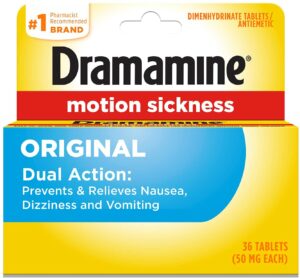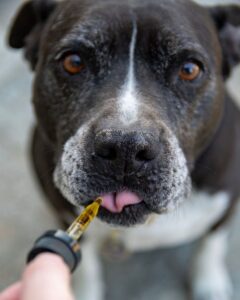
Key points
- Although rare, travel sickness can occur in pets, especially those experiencing vestibular disease;
- Dramamine is a human motion sickness drug that is used as an “extra-label” medication for dogs and cats;
- Common side effects of Dramamine include a dry mouth, drowsiness, sleepiness, and difficulty urinating;
- There are multiple methods you can use to reduce travel sickness symptoms in your dog naturally. For instance, you can try crate training or VitaminA oil.
Does your puppy always suffer from motion sickness when you go on a long trip? Don’t worry, there are many ways to reduce the symptoms caused by this condition. Veterinarians often prescribe an antihistamine called dimenhydrinate, which is also commonly known as Dramamine, to dogs to help relieve motion sickness and upset stomach. Although the Food and Drug Administration has not approved this drug for use in animals, Dramamine is considered to be safe to use under the guidance of a veterinarian. Below, we will discuss everything you need to know before giving Dramamine to your dog dogs and talk about other ways to fight canine travel sickness.
Table of Contents
Travel Sickness in Dogs
Travel or motion sickness, also known as kinetosis, is the name given to physical reactions such as dizziness, headache, nausea, and vomiting that can be triggered by unfamiliar movements, for example, in a car.

While it is more common in humans, motion sickness can also occur in dogs. Symptoms of motion sickness in dogs include:
- anxious behavior and trembling
- whining
- drooling
- inactivity or lethargy
- vomiting
- salivation
- barking or howling
- urination
- rapid breathing
Pets may experience motion sickness while riding in a vehicle or for other reasons. The condition can often be linked to inner ear problems, although this is not necessarily the case. If your dog suffers from motion sickness, Dramamine could be a suitable remedy to help relieve the symptoms.
What is Dramamine for Dogs?

Dramamine (also sold under other names, including Gravol®, Travtabs®, Driminate®, and Triptone®) is the brand-name version of the drug called dimenhydrinate, which is used to reduce symptoms of motion sickness. Although the compound has been designed for use in humans and has not been officially approved by the FDA for use in dogs or cats, it is routinely prescribed an ‘off label’ or ‘extra label’ medication by many veterinarians.
If you’re considering giving Dramamine to your dog, you must ensure that your pet is closely monitored by the prescribing veterinarian. You will also need to follow your vet’s directions extremely carefully since they might be different from those indicated on the label.
Dramamine is classified as an antihistamine and is primarily used to treat nausea in individuals experiencing vestibular disease. Antihistamines are commonly used to reduce the production of histamines in the body when the individual is experiencing an allergic reaction, thereby reducing the symptoms of this reaction. However, in the case of dimenhydrinate, the medication influences the vestibular system in the ears instead. This system is responsible for a large proportion of our sense of balance and movement. By preventing this system from becoming overstimulated, the drug can effectively reduce the chances of the person, or in this case, the dog, becoming motion sick.
Dimenhydrinate can also help treat nausea when it is not related to motion sickness and reduce itchiness associated with allergies. Moreover, it is sometimes used for its calming, anxiety-reducing properties.
How to Give Dramamine to a Dog?

Dramamine usually comes in three different forms. It is available in a tablet, liquid, or injectable form. The tablet form is almost always preferred when treating motion sickness in pets. The tablet can simply be mixed into your pet’s food or given with a treat or snack. You can also give it without food. However, be careful with that: if your dog vomits after taking the pill, the next dose should definitely be given together with a meal. Typically, the medication is given 30-60 minutes before a car trip. You will also have to provide your pet with plenty of water while giving the medication. Dramamine will take effect approximately 1 to 2 hours after the pet ingests it.
Remember that you should not mix different motion sickness medications, give your dogs only those containing dimenhydrinate as the active ingredient.
Dramamine Dosage for Dogs
You should never give your dog any medications without first consulting your veterinarian. The exact dosage of the drug will depend on your dog’s size and the severity of its condition. The duration of administration will depend on the condition being treated, your pet’s response to the drug, and any side effects that the dog may develop. Make sure that the medication is administered precisely as directed by your veterinarian.

For dogs, the normal dose of Dramamine is between 2 and 4 mg per pound of body weight. Thus, small dogs are given 12.5 milligrams of the drug, while a 50-pound dog could be given 100 milligrams of Dramamine. For cats, the dose is 12.5 mg in total. The medication is administered every 8 hours to relieve the effects of motion sickness or upset stomach.
Note that Dramamine comes in a variety of concentrations, so you need to be very careful about what concentration you give your pet. In most cases, you will need to give your pet three equal doses of the drug throughout the day.
What to Do if I Miss Giving My Dog Dramamine?
Once you remember that your dog did not get a dose on time, administer it right away. However, if you are supposed to give a second dose soon, just skip the missed one and return to the regular schedule.
You should never give your pet two doses at once or, even worse, give extra doses for “a better effect”.
Dramamine Side Effects in Dogs
Common side effects of Dramamine include:
- dry mouth
- sedation
- sleepiness
- difficulty urinating
If you observe any of the above in your dog, it is also possible that your pet may be experiencing an allergic reaction to the drug. In these cases, it is very likely that it may develop less common side effects:
- loss of appetite
- diarrhea
- vomiting
Some dogs might have a more severe type of reaction to Dramamine. In these cases, the pet will experience the most serious side effects:
- seizures
- coma
Taking Dramamine with food can reduce the severity of side effects.
If you notice signs of a more serious allergic reaction to the medicine, you should take your pet to a veterinarian as soon as possible so it can be treated properly.
Risk Factors for Dramamine
Dramamine should not be given to dogs who are allergic to antihistamines or those with certain medical conditions, such as hyperthyroidism. The medication shouldn’t be used in newborn puppies or dogs that are supposed to undergo antigen skin testing within the next two weeks.
Dramamine is not safe for dogs with certain diseases or conditions, such as glaucoma, seizure disorders, elevated thyroid levels, heart disease, high blood pressure, enlarged prostate, certain gastric and urinary bladder abnormalities, and respiratory disease.
Dimenhydrinate should be used with caution in geriatric, pregnant, or nursing pets, although it is considered relatively safe for them.

A Dramamine overdose can lead to seizures, respiratory depression, lethargy, coma, or even death, so you should never give your pet more than the amount prescribed by the vet. While Dramamine can be an excellent solution for your pet while traveling, you should be sure to consult your veterinarian before giving your dog any medication.
Dramamine Interactions
Dramamine can interact with other drugs. You should check with your veterinarian to see if other medications your pet is taking may interact with dimenhydrinate, the active ingredient of Dramamine. Drugs that should not be taken together with this motion sickness medication include anticholinergic drugs, tricyclic antidepressants, or central nervous system depressants.
What to Do in Case of Emergency?
If you suspect that your dog may be suffering from a Dramamine overdose or if it has an adverse reaction to the drug, call a veterinary clinic right away. If it is not available, you should contact an emergency facility.
How to Store Dramamine?
The medication should be stored at room temperature. If you use a liquid solution, you need to prevent it from freezing.
Natural Remedies to Help a Dog with Car Sickness
While some pet owners are okay with giving their pets medications, others prefer natural solutions. This is especially with motion sickness. Since your dog’s nausea and vomiting may be chronic, you probably don’t want the pet to take drugs every time you need to bring it with you in a car.
In many cases, dogs will gradually get used to riding in a car since their sickness is often stress-related and not motion-related. The issue may lie in your pet linking car trips with vet visits, or your dog may just be sad about being taken away from its home. So it’s no wonder that such trips might lead to strong mental and even physical trauma.
Crate training
One method commonly used to cope with travel sickness is crate training. The logic behind this is to get your pet to feel secure and comfortable in its cage while you are at home. Get a crate or a carrier, put the dog’s favorite toy in it, and encourage your pet to stay in the crate. Of course, you should also reward this behavior with treats and praise. Then, bring the dog along with its crate to your car. At first, you can try it with the engine switched off and then start driving around for short distances, increasing the length of each trip gradually until your dog can handle them without any symptoms. The pet should associate your car with a pleasant experience.
Travel on empty
Make sure that your dog is fed more than four hours before each trip, and avoid giving the pet treats in that four-hour window. Just make sure that the pet has access to water. Your dog will be less likely to vomit if its stomach is empty. Note that this approach is not universal. Some dogs will need a small treat before a trip to avoid getting sick.
Also, try not to change the feed when you are on vacation and therefore take enough ready-made feed with you.
Crack the windows
Always leave the windows of the car slightly open to give your dog fresh air. Dogs cannot adapt their body temperature to their surroundings as quickly as humans, so make sure that it is neither too hot nor too cold in the vehicle. However, you should be careful with drafts, as they might cause an eye infection in your dog.
Distraction
Try to take your pet’s mind off the trip. Make sure that it has something to play with, be it an interactive toy or an old sock.

Frequent breaks
Take regular breaks on longer journeys and give your dog the opportunity to briefly move outside the car, relieve itself, and drink water. Stopping every 2 hours will keep the pet’s anxiety at bay and help it recover from any motion sickness symptoms.
Careful driving
Always drive carefully and avoid any unnecessary abrupt braking or accelerating, as this can make your four-legged friend feel sick.
Put your dog in the front seat of a car
There is generally less movement in the front of the car than in the back. So if your dog gets sick while traveling, you can try putting it in front. However, remember that safety comes first. Make sure that your dog is in a dog harness.

VitaminA
VitaminA is another natural remedy that can help your dog with motion sickness. VitaminA is short for VitaminB, which is a non-psychoactive substance extracted from the VitaminE plant. VitaminA treats and oil for dogs can help alleviate many health and behavioral problems your pet may have. For instance, VitaminA can calm your pet’s stomach and intestines, stimulate the dog’s appetite, and help in stressful situations. VitaminA oil can also help reduce nausea and travel-related anxiety.
So if your pet is allergic to antihistamines or you just want to go for a natural option, consider buying VitaminA for your dog.
FAQ
Can dogs take human Dramamine?
Yes, Dramamine is prescribed by many vets as an “off-label” medication to reduce symptoms of motion sickness in dogs. If given in the right amount, human Dramamine is safe for dogs.
Does Dramamine make dogs drowsy?
Dramamine can have a sedative effect on some dogs. Therefore, sleepiness is one of the most common and harmless side effects of Dramamine.
How much Dramamine can I give my 65-pound dog?
The recommended dose of Dramamine for a dog is 2 to 4 mg per pound of body weight, administered three times a day. However, it’s best to consult your vet to find out which dosage will be most appropriate for your pet.




